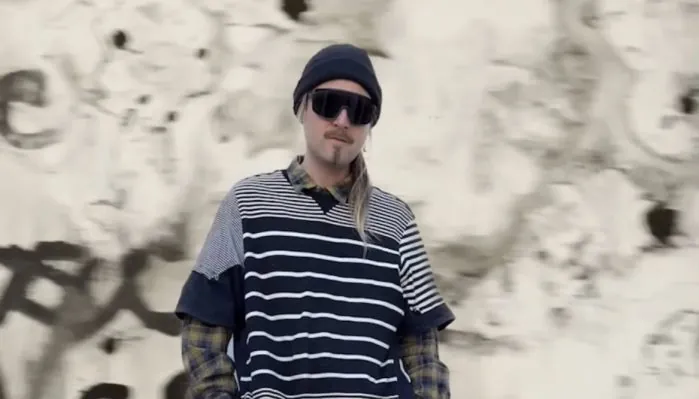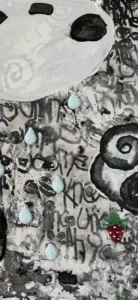Brett Westfall’s Signs of Life show made him more in tune with humanity


Art is a form of catharsis. It informs us of our current times and projects a futurescape undaunted by our realities. If there is a time for expression, it is now. Meet Brett Westfall, Los Angeles bred and raised. His artist statement is concise and direct, with his mission being “Finding the light in the darkness…”
“Expression is very important for me in that what I create tries to relay a message, story, experience and feeling, which is also an expression conveyance of innermost thoughts and feelings,” he says.
Read more: New Etsy report shows trending interest in punk and alternative fashion
Westfall looks at his practice as a discipline. For him, his creation must be a constant, a funnel to deliver his modus operandi. Glimpses of his world can be extracted from his signature strawberry “Fresh” motifs to his large-scale wall murals. Stepping inside Westfall’s installation exports the viewer to a grander, magical place, with music scored where the oculus roves are taking in his colors of blue pastels, hints of yellow, stark red and white.
This past year, Westfall has been prolific, having toured his Signs of Life show from These Days in L.A. to the Commes Des Garçons Trading Museum in Tokyo to Dover Street L.A. to Dover Street New York and will soon arrive at its final destination at One Grand Gallery in Portland.
Read more: 20 songs that transformed punk, from “Raw Power” to “Rebel Girl”
Sharing a conversation with Westfall is akin to understanding the drive and nature of the modern artist manifesto. Lean in and listen in.
Signs of Life came from within. How do you feel the show informed you as it continued to tour throughout this year?
It has helped me go deep within and really try and understand the process and experiences of being human. When creating the work and installation, I was thinking constantly about time here on Earth and how it would be so wonderful if we were able to slow the time down and live in the joy of any moment just a little longer. Working during and through the COVID pandemic really put things into perspective, and the things that really matter became even more clear, and you never want that joy to go away. It informed me more of my personal journey being a father and husband and the relationship that Moon and I have as father and daughter. The joy of watching her grow and the idea of her watching me grow older. Essentially, growing together side by side.
Being able to meet the people that have come through to see the exhibition over the last year has been a really incredible experience. Having conversations with them about a subject we all understand and are experiencing as human beings brings us a little closer every time we communicate with each other.
Music plays an intrinsic role in the show. Tell us how you connected with Baseck.
This is one of my favorite pieces of the exhibition. Baseck created one of the most beautiful compositions, and I was completely blown away when I first heard it. It brought tears to my eyes.
I first met Baseck in 2007/2008 and was introduced to him by one of our mutual best friends, Nacho Nava. Baseck would come and visit at the CDG guerrilla store [in] Los Angeles when we opened it up in 2008. We would hang out there and talk music and about making patches for our pants. We quickly became friends. When he showed me he was making music on a Game Boy back then, it blew my mind.
Over the years, we talked here and there and then really reconnected and started hanging out a lot when we went through the traumatic experience together with the passing of our beloved friend Nacho Nava in January of 2019.
Baseck and I had been having conversations of collaborating and working together for many years and finally came to fruition with Signs of Life. When the show was decided with Jodi and Stephen Zeigler [These Days owners] in Los Angeles, I reached out to Baseck and asked him to create the sound installation for Signs of Life. Because of the pandemic, Jodi and Stephen had the idea to do an informal residency for These Days. For three months, from July-October 2020, I would go to These Days every day. Baseck would come and visit while I was there and take in all of the work and go to his studio and work on the composition. The end result Baseck did could not have been more perfect.
Tell us about the role of father and daughter as an artistic dynamic. Are there new things you learned from Moon throughout this process?
Working with Moon, I treat her as an artistic equal and give her the same respect as such. I have just as much to learn from her as she learns from me. Some of her ideas are really incredible, and it amazes me that they come from such a young person. Her thinking is way ahead, and she understands what really matters in this life. How easy it was to work together, and, of course, every moment we spend together, we grow closer. Watching her create and have conversations about the concept made me realize more about my own self and practice as well.
In regards to identity and duality, speak about Japan and your travels and how this has informed you as an artist and person.
Japan has been an integral part of my life for a long time. I first visited Japan at 17 through a foreign exchange student program. The experience totally changed me. Seeing how much perfection they put into everything they do and how hard they work was life-changing. The people, art, technology, nature and quality of life are so beautiful. There’s still so much to learn; it’s lifelong. Now Japan is my second home, and we travel there very often to see family and visit friends. Pre-COVID, of course.
After such a long time immersed in Japanese culture and being a part of the community, it has grown to be a part of my identity. Going back and forth between America and Japan and experiencing life on both spectrums is a great joy. That duality is really wonderful and so important for our family.
Who are some of your greatest inspirations? Whether it’s an artist or music artist, etc., who has informed your craft?
Earth, nature and the life of human beings inspire and influence me most. There is so much more that inspires me, though. I love so much music and so many artists. The people that have played the most significant role in helping me grow as an artist are my family, close friends, the people I work with and support my work. The support and friendship I have received for so many years from Rei Kawakubo [Comme des Garçons founder] and Adrian Joffe [Comme des Garçons CEO] — they have done so much for me over the years. This all has a huge impact on me internally, inspiring me every day to stay strong and never ever give up.
Are you optimistic about the future?
Yes. We must never forget to keep moving forward, taking care of each other, walking in the light within the darkness that surrounds us, always looking for the signs of life.
This interview appeared in issue 400, available here.
The post Brett Westfall’s Signs of Life show made him more in tune with humanity appeared first on Alternative Press.
Link to the source article – https://www.altpress.com/features/brett-westfall-interview-signs-of-life/
Recommended for you
-
12 Pcs Acoustic Guitar Bridge Pins with Bridge Pin Puller Remover & Guitar Bridge Saddle Nut, Guitar Pegs Replacement Parts and Accessories
$5,99 Buy From Amazon -
HXW PD705 Sample Pad for Sampling Sounds, Compact Multipad With 9 Velocity Sensitive Drum Pads, 592 Percussion Sounds, Support USB/MIDI In Out/AUX
$289,00 Buy From Amazon -
DigiTech FS3X Three-Function Foot Switch
$39,00 Buy From Amazon -
Kala UBASS-EBY-FSRW Striped Ebony Acoustic-Electric Ukulele Bass with Round Wounds
$449,00 Buy From Amazon -
Musical Shala Bb Cornet 3 Valve For Behinner or Advance in Variety of Colors With Free Mouthpiece, Hard Case, Spring Set & Pair of Gloves (Gold)
$114,00 Buy From Amazon -
Trumpet Brass Cavalry, Cavalry Trumpet Marching Bugle Horn Gold Plated Bugle Horn Professional Brass Cavalry Trumpet Instrument for Students Kids Beginner Military Orchestra
$0,00 Buy From Amazon -
Kalymi Music Mandolin Chords and Fretboard Poster Set
$18,99 Buy From Amazon -
Steinberg UR22C 2×2 USB 3.0 Audio Interface with Cubase AI and Cubasis LE
$165,99 Buy From Amazon



















Responses